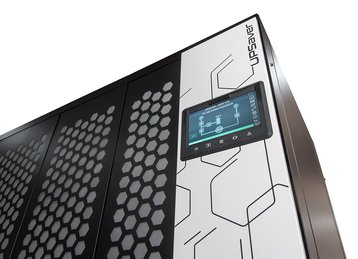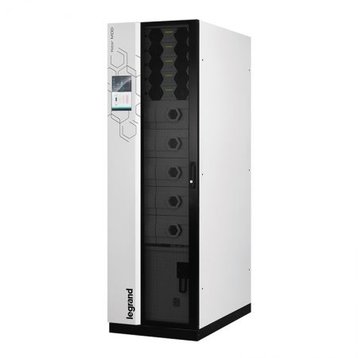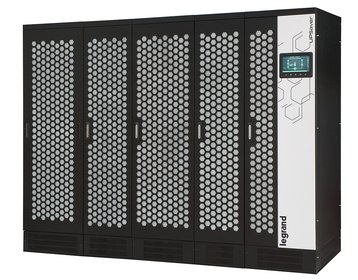In the dynamic landscape of data center management, the significance of a stable and reliable power supply cannot be overstated. As every data center operator will understand, maintaining a dependable power infrastructure is the cornerstone of operational continuity.
The latest insights from the Uptime Institute's 2024 Annual Outages Analysis report underscore this imperative, revealing that power-related issues remain the primary cause of significant data center outages, accounting for 52 percent of all disruptions. Moreover, 42 percent of these outages are directly attributed to uninterruptible power supply (UPS) failures, highlighting the urgent need for robust UPS solutions tailored to the unique demands of modern data environments.
The need for UPS systems
UPS systems play a vital role in ensuring the continuous operation of data centers. These systems protect sensitive electronic equipment from disturbances in the mains supply, such as voltage dips, blackouts, or voltage surges.
Without proper protection, these electrical events can lead to service interruptions, data loss, or even damage to electronic devices, posing significant risks to businesses and individuals alike. Ensuring your UPS system is reliable and efficient is a critical factor in maintaining data center uptime.
Data centers have three primary needs:
- Resiliency: Data centers must ensure that their servers keep running, even in the face of problems and anomalies in the infrastructure
- Adaptability: Data centers must frequently evolve and be upgraded quickly to meet changing demands and technologies
- Cost containment: Data center infrastructures consume substantial resources, including space and energy. Therefore, closely monitoring and controlling costs and energy consumption is crucial
While UPS systems are commonly known for ensuring resilience, it's important to recognize that their size also plays a crucial role in adaptability and cost management. So, what key factors must you consider when selecting the most suitable UPS and size for your data center?
Factors to consider when selecting a UPS
When it comes to choosing the right UPS for your data center, several critical factors must be considered. To help you navigate this decision-making process effectively, let's break these factors down.
Power calculation
Calculating the UPS power and the necessary batteries for the desired backup duration is vital. Precise UPS sizing requires identifying all the supporting loads and their power ratings.
Begin by determining the power requirements of your devices. Consider both active loads (servers, storage devices, and electronic equipment used for data processing and communication) and mechanical loads (such as cooling systems and ventilation equipment). Calculate the total power needed and ensure your UPS can provide the required power and wattage.
- Step 1: Collect all the power ratings of the supplied devices to find the overall VA (Volt Ampere) needed and then calculate the maximum active power (Watts) for each. You can get the required total maximum active power by adding up the overall power.
- Step 2: Select a UPS that can provide the needed VA and Watts. For example, with a load totalling 100 kVA PF 0.9 (90 kW), the UPS must be sized at least to provide 100 kVA and 90 kW. It's wise to oversize the UPS slightly to avoid overloads and ensure uninterrupted operation during load fluctuations.
Battery autonomy
After establishing the load’s power, batteries can be sized to achieve the desired autonomy period, which denotes the duration for which the UPS can continue to feed its loads in the event of a power outage.
- Step 3: Calculate the battery size based on the required autonomy time, but with a worst-case scenario in mind, where the minimum autonomy is calculated based on the absolute maximum load. This method guarantees that the system will consistently maintain at least the minimum required autonomy, even when the load is at its maximum capacity of 100 percent.
- Step 4: Consider potential variations due to factors like battery aging and temperature and apply a design margin by slightly oversizing the battery set to account for these potential variations.
UPS performance and architecture
To enhance reliability and adaptability, choose UPS systems with redundancy and scalability. Consider factors like redundancy levels and battery architecture.
- Redundancy: Parallel and modular architectures enhance reliability and availability by having more UPS units than the minimum required. This setup ensures continuous operation, even if one UPS or power module fails
- Scalability: Parallel and modular architectures offer easy expansion to meet changing demands. If there's an increase in active load and power demand, additional UPS units or power modules can be seamlessly added in parallel. This feature, known as 'power on demand' or 'pay as you grow,' optimizes Capex by only buying power when necessary
- Serviceability: Scalable and modular designs simplify installation and replacement, reducing operational costs. Additional features such as total front access, advanced diagnostics, user-friendly displays, and remote monitoring further contribute to savings on service and management expenses
Energy consumption and efficiency
Assess UPS efficiency to minimize energy consumption and operating costs.
- Efficiency ratings: Look for UPS systems with high efficiency ratings across a range of load levels, not just at nominal power. Consider how efficiency fluctuates as load levels change, especially in redundant setups where UPS units may operate at lower loads
- Architecture: Choose UPS systems with modular or scalable architectures, as they tend to maintain higher efficiency levels due to flexible power modules and automatic power adjustment techniques. Such designs optimize efficiency even when operating at partial loads, reducing energy wastage
- Advanced features: Consider UPS systems with advanced battery charge management systems and other features aimed at enhancing efficiency
When selecting a UPS system for your data center, there is no one-size-fits-all approach. Each type of system comes with its own advantages and disadvantages, and careful consideration must be given when selecting one.
Data center managers should work closely with UPS manufacturers to identify the best solution for their requirements and consider factors such as energy efficiency and long-term cost savings. Making the right choice can contribute to a highly efficient and resilient data center operation.
Legrand, a global specialist in electrical and digital building infrastructures, offers a comprehensive range of UPS solutions, from compact single-phase units to modular three-phase systems designed to meet the diverse needs of modern data center environments.
Need help identifying the best UPS solution? Contact Legrand for an online demo or consultation here.
Stefania Ceccarini, product specialist at Borri, a brand of Legrand, contributed to this article.







